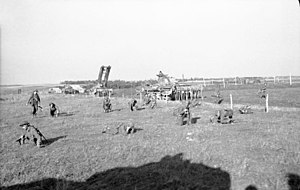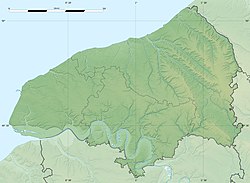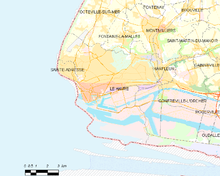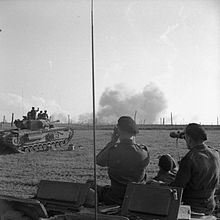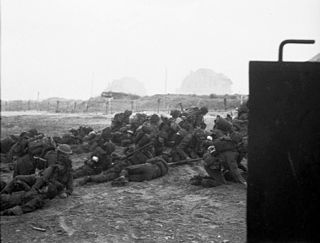
Sword, commonly known as Sword Beach, was the code name given to one of the five main landing areas along the Normandy coast during the initial assault phase, Operation Neptune, of Operation Overlord. The Allied invasion of German-occupied France commenced on 6 June 1944. Stretching 8 kilometres (5.0 mi) from Ouistreham to Saint-Aubin-sur-Mer, the beach proved to be the easternmost landing site of the invasion after the abortion of an attack on a sixth beach, code-named Band. Taking Sword was to be the responsibility of the British Army with sea transport, mine sweeping and a naval bombardment force provided by the British Royal Navy as well as elements from the Polish, Norwegian and other Allied navies.

Operation Goodwood was a British offensive during the Second World War, which took place between 18 and 20 July 1944 as part of the larger battle for Caen in Normandy, France. The objective of the operation was a limited attack to the south, from the Orne bridgehead, to capture the rest of Caen and the Bourguébus Ridge beyond. At least one historian has called the operation the largest tank battle that the British Army has ever fought.

The Normandy landings were the landing operations and associated airborne operations on Tuesday, 6 June 1944 of the Allied invasion of Normandy in Operation Overlord during World War II. Codenamed Operation Neptune and often referred to as D-Day, it was, and still is, the largest seaborne invasion in history. The operation began the liberation of France and laid the foundations of the Allied victory on the Western Front.

Operation Cycle is the name of the evacuation of Allied troops from Le Havre, in the Pays de Caux of Upper Normandy from 10–13 June 1940, towards the end of the Battle of France, during the Second World War. The operation was preceded by the better known rescue of 338,226 British and French soldiers from Dunkirk in Operation Dynamo (26 May – 4 June). On 20 May, the Germans had captured Abbeville at the mouth of the Somme and cut off the main Allied armies in the north. South of the river, the Allies improvised defences and made local counter-attacks, to dislodge the Germans from bridgeheads on the south bank and re-capture river crossings for an advance northwards to regain contact with the armies in northern France and Flanders.
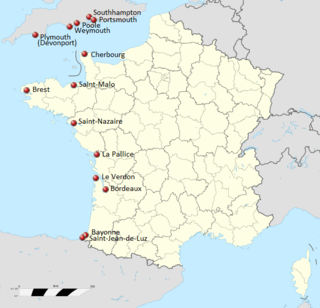
Operation Aerial was the evacuation of Allied forces and civilians from ports in western France from 15 to 25 June 1940 during the Second World War. The evacuation followed the Allied military collapse in the Battle of France against Nazi Germany. Operation Dynamo, the evacuation from Dunkirk, and Operation Cycle, an embarkation from Le Havre, finished on 13 June. British and Allied ships were covered from French bases by five Royal Air Force (RAF) fighter squadrons and assisted by aircraft based in England, to lift British, Polish and Czech troops, civilians and equipment from Atlantic ports, particularly from St Nazaire and Nantes.

Gold, commonly known as Gold Beach, was the code name for one of the five areas of the Allied invasion of German-occupied France in the Normandy landings on 6 June 1944, during the Second World War. Gold, the central of the five areas, was located between Port-en-Bessin on the west and the Lieu-dit La Rivière in Ver-sur-Mer on the east. High cliffs at the western end of the zone meant that the landings took place on the flat section between Le Hamel and La Rivière, in the sectors code-named Jig and King. Taking Gold was to be the responsibility of the British Army, with sea transport, mine sweeping, and a naval bombardment force provided by the Royal Navy as well as elements from the Dutch, Polish and other Allied navies.
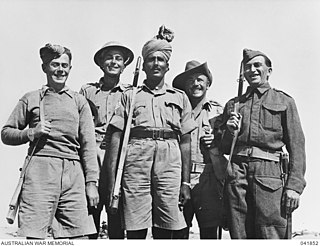
The siege of Tobruk took place between April 10 and November 27, 1941, when elements of the Allied Army were trapped and besiged in the North African port of Tobruk by German and Italian forces. The defenders quickly became known as the Rats of Tobruk.

The Battle of Gazala was fought during the Western Desert Campaign of the Second World War, west of the port of Tobruk in Libya, from 26 May to 21 June 1942. Axis troops of the Panzerarmee Afrika consisting of German and Italian units fought the British Eighth Army composed mainly of British Commonwealth, Indian and Free French troops.

Operation Charnwood was an Anglo-Canadian offensive that took place from 8 to 9 July 1944, during the Battle for Caen, part of the larger Operation Overlord in the Second World War. The operation was intended to capture the German-occupied city of Caen, which was an important objective for the Allies during the opening stages of Overlord. It was also hoped that the attack would forestall the transfer of German armoured units from the Anglo-Canadian sector to the American sector to the west, where an offensive was being prepared. The British and Canadians advanced on a broad front and by the evening of the second day had taken Caen up to the Orne and Odon rivers.

The Battle for Caen is the name given to fighting between the British Second Army and the German Panzergruppe West in the Second World War for control of the city of Caen and its vicinity during the larger Battle of Normandy. The battles followed Operation Neptune, the Allied landings on the French coast on 6 June 1944 (D-Day).

The siege of Dunkirk in World War II began in September 1944, when Allied units of the Second Canadian Division surrounded the fortified city and port of Dunkirk. The siege lasted until after the official end of the war in Europe. German units within the fortress withstood probing attacks and as the opening of the port of Antwerp was more important, the 21st Army Group commander, Field Marshal Bernard Montgomery, decided to contain but not capture Dunkirk with the 1st Czechoslovak Armoured Brigade. The fortress, commanded by Admiral Friedrich Frisius, eventually surrendered unconditionally to Brigadier General Alois Liška, the commander of the Czechoslovak brigade group, on 9 May 1945, a day after the surrender of Nazi Germany took effect.

Operation Martlet was part of a series of British attacks to capture the French town of Caen and its environs from German forces during the Battle of Normandy of World War II begun by the Allies. It was a preliminary operation undertaken on 25 June 1944 by XXX Corps of the British Second Army, to capture Rauray and the area around Noyers. The attack was to protect the right flank of VIII Corps as it began Operation Epsom, an offensive into the Odon Valley west of Caen, on 26 June. The 50th (Northumbrian) Infantry Division and the 49th Infantry Division were to capture Juvigny-sur-Seulles, Vendes and Rauray, to prevent German counter-attacks against VIII Corps from the area of the Rauray Spur and then extend the attack towards Noyers and Aunay-sur-Odon. It was the first time in Normandy that the 49th Division operated as a division.
The 4th Special Service Brigade was a brigade-sized formation of the British Commandos formed during the Second World War in March 1944 from battalion-sized units of the Royal Marines. Due to the success of the British Army Commandos' operations in Norway, the Channel Islands, St. Nazaire, and the Middle East, the Admiralty dissolved the Royal Marines Division in late 1942 and reorganized its amphibious assault infantry into eight additional Commando units.
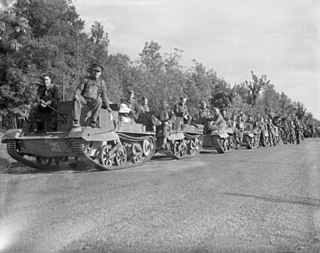
The British Expeditionary Force (BEF) was the contingent of the British Army sent to France in 1939 after Britain and France declared war on Nazi Germany on 3 September, beginning the Second World War. The BEF existed from 2 September 1939 when the BEF GHQ was formed until 31 May 1940, when GHQ closed down and its troops reverted to the command of Home Forces. During the 1930s, the British government had planned to deter war by abolishing the Ten Year Rule and rearming from the very low level of readiness of the early 1930s. The bulk of the extra money went to the Royal Navy and the Royal Air Force but plans were made to re-equip a small number of Army and Territorial Army divisions for service overseas.
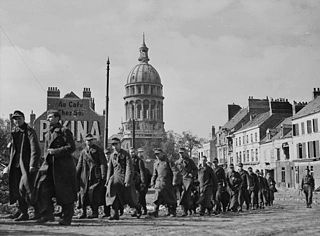
Operation Wellhit from 17 to 22 September 1944, was an operation of the Second World War by the 3rd Canadian Division of the First Canadian Army to take the fortified port of Boulogne in northern France. The 9th Canadian Infantry Brigade had hoped to take Boulogne off the march as it advanced up the coast but it was stopped by the German fortifications 5 mi (8.0 km) from the city.

Operation Undergo was an attack by the 3rd Canadian Infantry Division on the German garrison and fortifications of the French port of Calais, during September 1944. A subsidiary operation was executed to capture German long-range, heavy artillery at Cap Gris Nez, which threatened the sea approaches to Boulogne. The operation was part of the Clearing the Channel Coast undertaken by the First Canadian Army, following the success of Operation Overlord and the break-out from Normandy. The assault on Calais used the tactics of Operation Wellhit at Boulogne, sealing the town, bombardments from land, sea and air, followed by infantry assaults supported by armour, including flame-throwing tanks and creeping barrages.

Clearing the Channel Coast was a World War II task undertaken by the First Canadian Army in August 1944, following the Allied Operation Overlord and the victory, break-out and pursuit from Normandy.
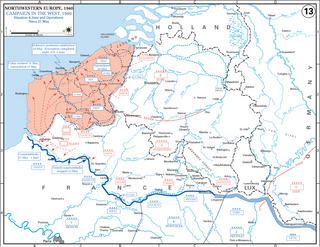
The Battle of Abbeville took place from 27 May to 4 June 1940, near Abbeville during the Battle of France in the Second World War. On 20 May, the 2nd Panzer Division advanced 56 mi (90 km) to Abbeville on the English Channel, overran the 25th Infantry Brigade of the 50th (Northumbrian) Infantry Division and captured the town at 8:30 p.m. Only a few British survivors managed to retreat to the south bank of the Somme and at 2:00 a.m. on 21 May, the III Battalion, Rifle Regiment 2 reached the coast, west of Noyelles-sur-Mer.

The 34th Armoured Brigade was an armoured brigade of the British Army that fought in the Second World War. It was formed in 1941 as the 34th Army Tank Brigade and renamed as the 34th Tank Brigade in February 1945, becoming part of the 79th Armoured Division. It was equipped with Churchill tanks and provided close support for assaults by the infantry. During the fighting in North-west Europe from July 1944 to May 1945 the brigade served with the First Canadian Army and the British Second Army. The brigade was disbanded in early 1946.

Operation Pheasant, also known as the Liberation of North Brabant, was a major operation to clear German troops from the province of North Brabant in the Netherlands during the fighting on the Western Front in the Second World War. This offensive was conceived as a result of the failure of Operation Market Garden and the allied effort to capture the important port of Antwerp. It was conducted by the allied 21st Army Group between 20 October to 4 November 1944.
